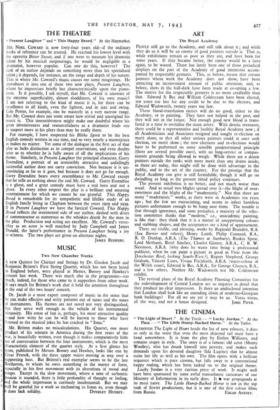ART
The Royal Academy
PEOPLE still go to the Academy, and still talk about it ; and while they do so it will be an enemy of good painters outside it. That is,
while exhibitions remain as poor as they are, and have been for some years. If they became better, the enemy would be a hero again, to be wooed. There has lately been one of those periodical displays on the part of the Academy of good intentions accom- panied by respectable gestures. This, as before, means that certain painters whose work the Academy does not show, have been attracting an inconvenient amount of public attention, and, as before, shots in the half-dark have been made at co-opting a few. The motive for the respectable gestures is no more creditable than that. Edward k Bas and William Coldstream have been elected, ten years too late for any credit to be due to the electors, and Edward Wadsworth, twenty years too late.
These blood-transfusion tactics will do no good, either to the Academy, or to painting. They have not helped in the past, and they will not in the future. Not enough good new blood is trans- fused at a time to revitalise the main artery. With drastic measures, there could be a representative and healthy Royal Academy now ; if all Academicians and Associates resigned and sought re-election on merit alone, so that all other serious painters could at once seek election, on merit alone ; the new elections and re-elections would have to be performed on some sensible predetermined principle (there are several possible ones), with no long-service or compas- sionate grounds being allowed to weigh. While there are a dozen painters outside the ranks with more merit than any dozen inside, as there are today, this might still be done with advantage to the public, and to the art of the country. For the prestige that the Royal Academy can give is still formidable, though it will go on dwindling as long as the present timid policy continues.
The present exhibition is no better, and not much worse than usual. And as usual two blights spread over it—the blight of over- sweetness and the blight of the "modernistic." Not that there arc many " modernistic " works, as there were in Academies ten years ago ; but the few are excruciating, and seems to infect harmless pictures unfortunate enough to be hung near them. The trouble is that through ignorance, and some prejudice, a majority of the selec- tion committee thinks that "modern," i.e., unacademic painting, is like that: they think that it is a matter of unappetising colours and stabbing shapes, and the acceptances are a kind of appeasement.
There are visible, and pleasing, works by Reginald Brundrit, R.A. (Sea Barrier and others), Henry Lamb, Philip Connard, R.A., R. 0. Dunlop, A.R.A. (The Thames at Sunbury), Ruskin Spear, Lord Methuen, Beryl Sinclair, Charles Ginner, A.R.A., C. R. W. Nevinson, A.R.A. (why does he waste time being a professional publicist, when he can paint a picture as good as View from the Dorchester Roof, looking South-West ?), Rupert Shepherd, George Graham, Vincent Lines, Vivian Pitchforth, A.R.A. (water-colour of the Welsh coast), Edward le Bas, - A.R.A., Sir George Clausen, R.A., and a few others. ,Neither Mr. Wadsworth nor Mr. Coldstream exhibit.
The revived plans of the Royal Academy Planning Committee for the redevelopment of Central London are so negative in detail that they produce no clear impression. Is there an undisclosed intention that London shall look like an unending chain of moderno-Georgian bank buildings? For all we see yet it may be so. Vistas vistas, all the way, and not a house designed. JOHN PIPER.


























 Previous page
Previous page